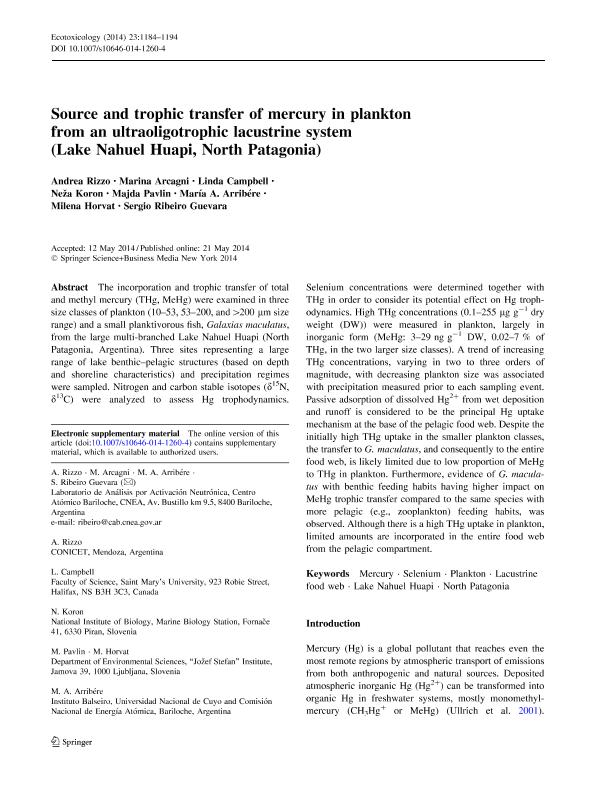Mostrar el registro sencillo del ítem
dc.contributor.author
Rizzo, Andrea Paula

dc.contributor.author
Arcagni, Marina

dc.contributor.author
Campbell, Linda
dc.contributor.author
Koron, Neža
dc.contributor.author
Pavlin, Majda
dc.contributor.author
Arribere, Maria Angelica

dc.contributor.author
Horvat, Milena
dc.contributor.author
Ribeiro, Sergio

dc.date.available
2018-01-10T18:01:07Z
dc.date.issued
2014-05
dc.identifier.citation
Ribeiro, Sergio; Horvat, Milena; Pavlin, Majda; Campbell, Linda; Rizzo, Andrea Paula; Koron, Neža; et al.; Source and trophic transfer of mercury in plankton from an ultraoligotrophic lacustrine system (Lake Nahuel Huapi, North Patagonia); Springer; Ecotoxicology; 23; 7; 5-2014; 1184-1194
dc.identifier.issn
0963-9292
dc.identifier.uri
http://hdl.handle.net/11336/32847
dc.description.abstract
The incorporation and trophic transfer of total and methyl mercury (THg, MeHg) were examined in three size classes of plankton (10–53, 53–200, and >200 μm size range) and a small planktivorous fish, Galaxias maculatus, from the large multi-branched Lake Nahuel Huapi (North Patagonia, Argentina). Three sites representing a large range of lake benthic–pelagic structures (based on depth and shoreline characteristics) and precipitation regimes were sampled. Nitrogen and carbon stable isotopes (δ15N, δ13C) were analyzed to assess Hg trophodynamics. Selenium concentrations were determined together with THg in order to consider its potential effect on Hg trophodynamics. High THg concentrations (0.1–255 µg g−1 dry weight (DW)) were measured in plankton, largely in inorganic form (MeHg: 3–29 ng g−1 DW, 0.02–7 % of THg, in the two larger size classes). A trend of increasing THg concentrations, varying in two to three orders of magnitude, with decreasing plankton size was associated with precipitation measured prior to each sampling event. Passive adsorption of dissolved Hg2+ from wet deposition and runoff is considered to be the principal Hg uptake mechanism at the base of the pelagic food web. Despite the initially high THg uptake in the smaller plankton classes, the transfer to G. maculatus, and consequently to the entire food web, is likely limited due to low proportion of MeHg to THg in plankton. Furthermore, evidence of G. maculatus with benthic feeding habits having higher impact on MeHg trophic transfer compared to the same species with more pelagic (e.g., zooplankton) feeding habits, was observed. Although there is a high THg uptake in plankton, limited amounts are incorporated in the entire food web from the pelagic compartment.
dc.format
application/pdf
dc.language.iso
eng
dc.publisher
Springer

dc.rights
info:eu-repo/semantics/openAccess
dc.rights.uri
https://creativecommons.org/licenses/by-nc-sa/2.5/ar/
dc.subject
Mercury
dc.subject
Selenium
dc.subject
Plankton
dc.subject
Lacustrine Food Web
dc.subject
Lake Nahuel Huapi
dc.subject
North Patagonia
dc.subject.classification
Meteorología y Ciencias Atmosféricas

dc.subject.classification
Ciencias de la Tierra y relacionadas con el Medio Ambiente

dc.subject.classification
CIENCIAS NATURALES Y EXACTAS

dc.title
Source and trophic transfer of mercury in plankton from an ultraoligotrophic lacustrine system (Lake Nahuel Huapi, North Patagonia)
dc.type
info:eu-repo/semantics/article
dc.type
info:ar-repo/semantics/artículo
dc.type
info:eu-repo/semantics/publishedVersion
dc.date.updated
2018-01-05T17:13:19Z
dc.identifier.eissn
1573-3017
dc.journal.volume
23
dc.journal.number
7
dc.journal.pagination
1184-1194
dc.journal.pais
Estados Unidos

dc.journal.ciudad
Nueva York
dc.description.fil
Fil: Rizzo, Andrea Paula. Comision Nacional de Energia Atomica. Gerencia D/area de Energia Nuclear. Unidad de Actividad de Ingeniería Nuclear. Laboratorio de Analisis por Activación Neutronica; Argentina. Consejo Nacional de Investigaciones Científicas y Técnicas; Argentina
dc.description.fil
Fil: Arcagni, Marina. Comision Nacional de Energia Atomica. Gerencia D/area de Energia Nuclear. Unidad de Actividad de Ingeniería Nuclear. Laboratorio de Analisis por Activación Neutronica; Argentina. Consejo Nacional de Investigaciones Científicas y Técnicas; Argentina
dc.description.fil
Fil: Campbell, Linda. Saint Mary’s University; Canadá
dc.description.fil
Fil: Koron, Neža. National Institute of Biology; Eslovenia
dc.description.fil
Fil: Pavlin, Majda. “Jožef Stefan” Institute; Eslovenia
dc.description.fil
Fil: Arribere, Maria Angelica. Comision Nacional de Energia Atomica. Gerencia D/area de Energia Nuclear. Unidad de Actividad de Ingeniería Nuclear. Laboratorio de Analisis por Activación Neutronica; Argentina. Comisión Nacional de Energía Atómica. Gerencia del Área de Energía Nuclear. Instituto Balseiro; Argentina
dc.description.fil
Fil: Horvat, Milena. “Jožef Stefan” Institute; Eslovenia
dc.description.fil
Fil: Ribeiro, Sergio. Comision Nacional de Energia Atomica. Gerencia D/area de Energia Nuclear. Unidad de Actividad de Ingeniería Nuclear. Laboratorio de Analisis por Activación Neutronica; Argentina. Consejo Nacional de Investigaciones Científicas y Técnicas; Argentina
dc.journal.title
Ecotoxicology

dc.relation.alternativeid
info:eu-repo/semantics/altIdentifier/doi/http://dx.doi.org/10.1007/s10646-014-1260-4
dc.relation.alternativeid
info:eu-repo/semantics/altIdentifier/url/https://link.springer.com/article/10.1007%2Fs10646-014-1260-4
Archivos asociados
